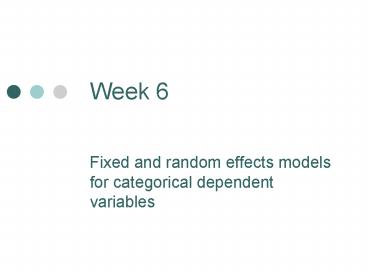Week 6 PowerPoint PPT Presentation
1 / 12
Title: Week 6
1
Week 6
- Fixed and random effects models for categorical
dependent variables
2
Overview
- Examine extension of fixed and random effects
models to categorical dependent variables
xtlogit, xptrobit - Examine extension to truncated dependent
variables xttobit - These are also called limited dependent
variables - Learn how to implement these models, interpret
output, test assumptions, decide between models.
3
Recap from week 1
- Developed for discrete (categorical) dependent
variables - Eg, psychological morbidity, whether one has a
job. Think of other examples. - Outcome variable is always 0 or 1. Estimate
- OLS (linear probability model) would set F(X,ß)
Xß e - Inappropriate because
- Heteroscedasticity the outcome variable is
always 0 or 1, so e only takes the value -xß or
1-xß - More seriously, one cannot constrain estimated
probabilities to lie between 0 and 1.
4
Extension of logit and probit to panel data
- We wont do the maths!
- But essentially, STATA maximises a likelihood
function derived from the panel data
specification - Both random effects and fixed effects
- Random effects is SLOW!!
- First, generate the categorical variable
indicating psychological morbidity - .
- gen byte PM (hlghq2 gt 2) if hlghq2 gt 0
hlghq2 ! .
5
Fixed effects estimates
Is losing a partner necessarily causing the
psychological morbidity?
- Losing a partner, being unemployed or sick, and
being in bad health are associated with
psychological morbidity - Negative in age throughout the human life span
6
Adding some more variables
- We know that women sometimes suffer from
post-natal depression. Try total number of
children, and children aged 0-2 - Total number of children is insignificant, but
children 0-2 is significant.
Next step???
7
Yes, we should separate men and women
- sort female
- by female xtlogit PM partner get_pnr lose_pnr
female ue_sick age age2 badh nch02, fe
Men
Women
- Relationship between PM and young children is
confined to women - Any other gender differences?
8
Back to random effects
- Estimates are VERY similar to FE
9
Testing between FE and RE
- quietly xtlogit PM partner get_pnr lose_pnr
female ue_sick age age2 badh nch02, fe - estimates store fixed
- quietly xtlogit PM partner get_pnr lose_pnr
female ue_sick age age2 badh nch02, re - hausman fixed .
- Random effects is rejected again.
10
Random effects probit
- No fixed effects command available, as there
does not exist a sufficient statistic allowing
the fixed effects to be conditioned out of the
likelihood.
11
Why arent the sets of coefficients more similar?
- Remember the conversion scale from Week 1
12
Random-effects Tobit
- No fixed-effects specification available
- Potential problems, if random effects is rejected
- And its not possible to use the Hausman test to
test this, since this relies on being able to
estimate fixed effects model.

